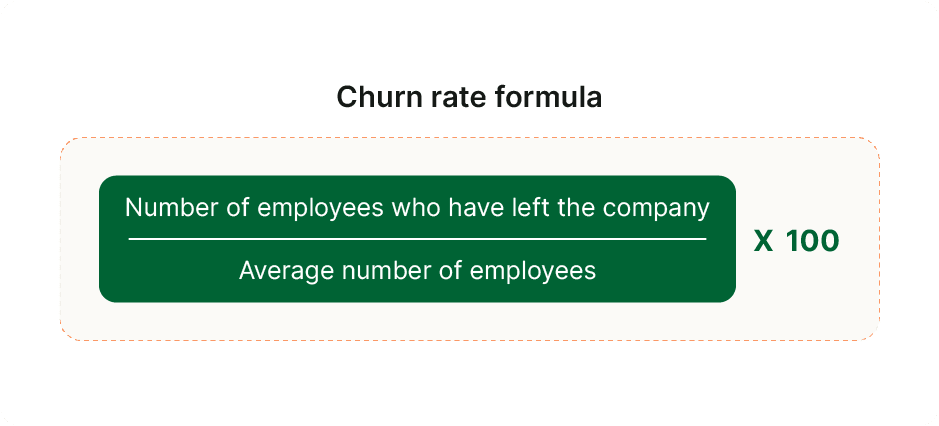Understanding, calculating and preventing high employee churn rates
Gain an understanding of employee churn rate, explore the factors influencing it and discover strategies to maintain low employee churn.
Gain an understanding of employee churn rate, explore the factors influencing it and discover strategies to maintain low employee churn.

In today's dynamic industry landscape, employee churn is more than just a statistic; it's a challenge that can profoundly impact an organization’s success and sustainability. Pew Research Center reported that “The Great Resignation” caused “widespread job losses and tight labor markets” — in turn setting off employee churn, with federal data reporting over 50 million resignations in 2022.
Businesses should be concerned about losing one of their most valuable assets: Their people. Employee churn disrupts workflows and leads to significant costs in recruitment, onboarding and lost productivity.
To tackle this issue effectively, organizations must understand what affects employee churn, and what steps they can take to lower employee churn rates for long-term retention.
Employee churn rate is a metric that measures the rate at which employees leave a company over a period, typically expressed as a percentage.
To calculate employee churn rate, take the number of employees who have left the company divided by the average number of employees, and multiply that by 100. You can use the following formula:

The distinction between employee churn rate, attrition and turnover lies in their underlying causes and implications.
| Employee churn rate | Attrition | Turnover |
| Focuses on the rate employees leave the organization. The data can be analyzed to determine reasons for voluntary departure. | A broader concept that encapsulates employee churn, but also covers involuntary employee departures, including layoffs or dismissals. | Considers both employee inflow and outflow. Turnover encompasses both voluntary departures and involuntary departures. |
Taking all three metrics into account allows HR professionals to understand not only the rate of departures but also the impact of those departures on the overall workforce.
Employee churn analysis helps determine patterns and underlying causes of employees leaving. During analysis, organizations collect data on factors like tenure, department, roles and reasons for leaving to spot trends.
Effective churn analysis enables data-driven decision-making, leading to improved retention, employee experience and organizational stability. It provides insights into workforce stability and indicates patterns of personnel leaving, helping management and HR address areas of concern and facilitate retention strategies.
Forbes describes a toxic work culture as one where employees “don’t feel valued, respected or supported,” citing factors such as high stress levels, poor communication from management, lack of trust and few opportunities for advancement. Toxic work environments can begin with poor direction from employers (with a trickle-down effect to employee level), or it can start from the ground up.
C-suites need to provide a clear company vision, communicate consistently and provide constant support for employees. They also need to make sure that they hire motivated workers with positive attitudes towards the company culture and job scope — otherwise, employees may demotivate each other and spread negative opinions that may lead to higher employee churn rates.
While keeping company roles updated in a fast-moving marketplace can be a challenge, companies that fail to define clear career progression paths risk high employee churn.
Employees thrive in environments that foster growth and advancement. Without proper updates and clear direction, employees may seek opportunities elsewhere; a report by Work Institute shares that in 2022, 22.3% of employees left their company for better career opportunities.
Fair compensation — including salary, commissions and bonuses — is crucial for employees, as many equate its financial value to their efforts and output. Benefits are an additional value-add, and oftentimes they’re a factor that employees consider when choosing to join or leave a company.
If compensation is below industry average or significantly disproportionate to employees' perceived effort, staff may feel undervalued and seek better-paying positions. Not offering benefits such as health insurance, retirement plans or paid time off can also lead to employee dissatisfaction, higher turnover and difficulty attracting new hires.
What constitutes work-life balance, or lack of it? Each employee defines the ideal work-life balance differently based on how much leisure and work time they prefer per week; regardless, several factors can be linked to it. These include high work demands, low control over their own jobs or tasks, unequal workload distribution and inflexible work arrangements.
Employees tend to resign when faced with little to no autonomy over their professional and personal lives, affecting employee churn rates within the company.
Some institutions are still hesitating to adopt remote work policies due to productivity and security concerns, collaboration communication difficulties and processes that aren’t easily adapted for work-from-home arrangements.
But from an employee perspective, remote or hybrid work arrangements can greatly improve staff working experience. Staff have more flexibility and agency, spend less time and money on daily commutes and have mutual trust with employers. Employees who don’t have these privileges at work may start looking for other companies that do offer such flexibility.
Companies should leverage the many digital tools available in the market to establish remote communication processes and facilitate virtual collaboration.
> Read more | Fortifying your organization’s remote workforce management
Positive recognition and appreciation are crucial for boosting employee morale. Recognition involves providing feedback based on results or actions tied to employees' achievements, while appreciation represents a simpler, more personal form of feedback.
It matters when management shows employees that their successes in the workplace have made an impact. When leaders fail to acknowledge achievements, recognize the value of their people, share constructive feedback and provide opportunities to develop skills in the workplace, employees may feel unappreciated, demotivated and ready to seek alternative employment.
Sometimes, employee journeys end sooner than expected. A survey by The Harris Poll found that nearly 10% of employees in the U.S. left a company soon after joining because of poor onboarding experiences.
To ensure effective onboarding, employers should provide timely resources, tools and training for new hires. This includes accurate employee documentation management, warm employee welcomes and assistance in adapting to tasks and the work culture. Without these measures, employee onboarding and training can be significantly affected.
Technology can streamline the hiring and onboarding process by enabling smooth communication, collecting paperwork and facilitating the employee's transition into the company and their team — even when done remotely.
It’s important to look out for and determine the cause of high employee churn rates, as they can be detrimental for several reasons:
Recognizing the impact of high employee turnover is key for businesses to enhance retention strategies, create a positive work environment and ensure long-term success.
To maintain long-term success within today's competitive business landscape, it’s crucial for organizations to act immediately once high employee churn rates are detected. Here are steps business leaders can take.
Companies should already be making use of employee churn analysis, which can help:
Employers should implement strategies to raise staff morale, including:
By offering competitive compensation and benefits packages, companies demonstrate to staff that their contributions, well-being and satisfaction are valued. Organizations can do this by:
Employees are more likely to stay with organizations that invest in their personal and professional development. Companies should:
Business leaders can address workplace toxicity by:
Versatile work options acknowledge the diverse needs and life circumstances of employees, greatly enhancing job satisfaction and retention. By offering remote work options, companies can also tap into a larger talent pool. It’s important that organizations:
A well-structured onboarding process can significantly reduce early turnover and lower employee churn rates. Companies can enhance onboarding by:
Effective document management plays a significant role in reducing employee churn organization-wide, starting with the epicenter of resource management: The HR department.
Effective HR document management involves providing a streamlined, organized system for HR staff to access valuable information. Digital employee file management systems allow for centralized storage and version control of all company documents, making it easier for HR to sort, securely store and locate up-to-date employee information.
Good document management supports the HR team throughout the entire employee lifecycle, from contracts to compliance, freeing up more time to focus on employee welfare and provide smooth onboarding experiences. With remote work becoming the norm, having a reliable document management system ensures
HR employees have access to the right documents and resources — giving new employees a smooth head start to their roles.
> Read more | 7 reasons your HR department needs a content services platform
For other departments, digital document management solutions improve access to information, streamline workflows, promote collaboration and communication and ensure compliance and risk management. This creates an efficient, meaningful and productive work environment for employees, reducing the risk of employee churn due to job dissatisfaction.
A robust document management solution should provide a comprehensive suite of features that work together to effectively process, organize, store securely and identify digital assets, which in turn empowers organizations to efficiently manage their document lifecycle and ultimately drive productivity and business success.
Hyland’s Intelligent Document Processing (IDP) software is an advanced intelligent document processing software that leverages AI for document classification, processing and intelligent data extraction efficiently and without much manual intervention.
By automating these tasks, Hyland IDP reduces the amount of time employees spend on manual classification and indexing, giving them the ability to focus on more meaningful work, and in turn increasing job satisfaction and reducing churn rates — and giving business leaders better autonomy for decision-making.
HR employees have access to the right documents and resources — giving new employees a smooth head start to their roles.
> Read more | The future of intelligent enterprise is AI-powered intelligent document processing (IDP)

HR teams play a crucial role in managing and maintaining employee information. Here's five improvements that come with a digitized approach to employee data management.

Explore how IDP is helping businesses across various industries transform their operations for enhanced efficiency.

IDC MarketScape recognizes Hyland’s extensive capability integration functionality and library, platform and capability ease of use